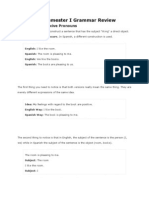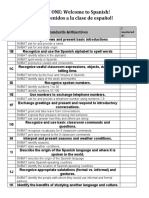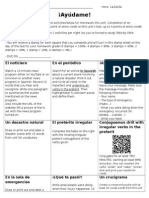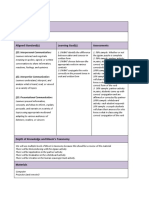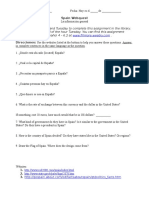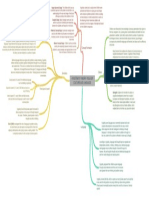CN Personality, Gustar, Sentence Structure
Uploaded by
Joaquin HernandezCN Personality, Gustar, Sentence Structure
Uploaded by
Joaquin HernandezNombre:_________________________________ Fecha: el 6 de marzo
What are today’s 3 key points?
1. Review _____________________________________ to talk about peoples’ personalities and
physical descriptions.
2. Review _____________________________________ to talk about the likes and dislikes of
yourself and others.
3. Know basic sentence __________________________ in Spanish and be able to unscramble
sentences.
Intro to New Material Key Point ONE:
Review SER
What are people like?
The expression changes depending on whom you are talking about:
Yo soy
means
Tú eres
means
É l es / Ella es
means
Nosotros/Nosotros somos
means
Ellos/Ellas/Ustedes son
means
Masculine adjectives end in ______________________________________ and describe BOYS.
Feminine adjectives end in ______________________________________ and describe GIRLS.
To make an adjective plural you add ____________ if the adjective ends in A, E, I, O, U.
If the adjective ends in a consanant you add ________________.
CHECKS FOR UNDERSTANDING:
1. 4.
2. 5.
3. 6.
Yo ______________________ _____________________________. (unorganized)
Antohny yo ______________________ _____________________________. (smart)
Jamira y yo ______________________ _____________________________. (organized)
Sharmika y Shakya ______________________ _____________________________. (patient)
Ronald y tu ______________________ _____________________________. (social)
Lamar ______________________ _____________________________. (creative)
Marcus ______________________ _____________________________. (athletic)
Tiffany y Alicia ______________________ _____________________________. (good)
Intro to New Material Key Point TWO:
Review GUSTAR
Me gusta
Te gusta
Le gusta
Other useful phrases:
¿y a ti?
a mi también
a mi tampoco
mucho
nada
un poco
CHECKS FOR UNDERSTANDING:
1. 4.
2. 5.
3. 6.
Intro to New Material Key Point ONE:
Know Basic Sentence Structure in Spanish
Subject Verb Noun Adjective
Structure: In Spanish, adjectives usually come after the noun.
REMEMBER: To make a sentence negative, place the word no BEFORE the verb:
1. Eduardo _____________________ un chico serio.
2. ________________________ jugar videojuegos.
The Questions
What are you like?: ¿Có mo eres? __________________________________
What is he/she like?: ¿Có mo es Ms. Harcrow? ___________________________________
SENTENCE SCRAMBLE
To practice talking about other people, let’s put these sentences together.
What’s the order we are looking for?
__________________ + ___________________ + ____________________ + _________________
1. creative es una chica Marina
________________________________________________________
2. es un Tito perezoso chico
________________________________________________________
3. deportista chica una es ella
________________________________________________________
4. Marcos chico un es reservado no
________________________________________________________
5. chico no él es simpá tico un
________________________________________________________
6. no una Teresa chica es paciente
________________________________________________________
Speak and Summarize!
First: Answer for yourself: ¿Có mo eres? _____________________________________
¿Que te gusta hacer? _____________________________________
Use these responses every time someone asks what you are like and what you like to do.
Second: Ask 7 to 10 classmates what they are like. Use: ¿Có mo eres?
Name Characteristic (in Likes to… Agree or Disagree?
Spanish)
Ex: Profa. Harcrow siempre paciente hablar por telefono con mi A mí también. OR A mí no.
familia
1.
2.
3.
4.
5.
6.
7.
8.
9.
10.
Then, summarize your findings with a paragraph ABOUT your classmates. This means you need to shift
to “él / ella es…” and write ABOUT each classmate that you talked to.
To start: Ms. Harcrow siempre es paciente. _____________________________________________
_________________________________________________________________________________
_________________________________________________________________________________
_________________________________________________________________________________
_________________________________________________________________________________
_________________________________________________________________________________
_________________________________________________________________________________
_________________________________________________________________________________
You might also like
- Spanish Tener Expressions - Note Taking Guide (Along With YT Video 5 - 45)0% (2)Spanish Tener Expressions - Note Taking Guide (Along With YT Video 5 - 45)2 pages
- Webquest: Las Escuelas en Los Países Hispanohablantes: InstruccionesNo ratings yetWebquest: Las Escuelas en Los Países Hispanohablantes: Instrucciones7 pages
- All or Nothing Systematicity Transcendental Arguments and Skepticism in German Idealism100% (1)All or Nothing Systematicity Transcendental Arguments and Skepticism in German Idealism450 pages
- Do Not Write On This: UNIT 2 Test: Mis Amigos y Yo Version - Spanish I - Ms. LeachNo ratings yetDo Not Write On This: UNIT 2 Test: Mis Amigos y Yo Version - Spanish I - Ms. Leach7 pages
- Intro To New Material: Key Point ONE Identify 14 ACTIVITY VERBSNo ratings yetIntro To New Material: Key Point ONE Identify 14 ACTIVITY VERBS5 pages
- Intro To New Material Key Point ONE: Know How To Ask For and Give Your Name in SpanishNo ratings yetIntro To New Material Key Point ONE: Know How To Ask For and Give Your Name in Spanish4 pages
- Topic 6 - Past, Present and Future Tense in Spanish100% (1)Topic 6 - Past, Present and Future Tense in Spanish19 pages
- Kelsey Winkel Lesson Plan : Warm - Up / Calentamiento 5 MinNo ratings yetKelsey Winkel Lesson Plan : Warm - Up / Calentamiento 5 Min5 pages
- Primary Theme: Families and Communities Secondary Themes:: Customs & Values Family Structure Social NetworkingNo ratings yetPrimary Theme: Families and Communities Secondary Themes:: Customs & Values Family Structure Social Networking2 pages
- Access Spanish: Student Book: A First Language Course (Access Language Series) by María Utrera Cejudo. Hodder & Stoughton (First100% (1)Access Spanish: Student Book: A First Language Course (Access Language Series) by María Utrera Cejudo. Hodder & Stoughton (First3 pages
- Our Favorite Mexican Food Lesson Plan Day 2100% (1)Our Favorite Mexican Food Lesson Plan Day 24 pages
- Ven Conmigo 1 Quizlet Vocabulary Spanish INo ratings yetVen Conmigo 1 Quizlet Vocabulary Spanish I5 pages
- What Are Today's 3 Key Points?: Nombre: - Fecha: El 5 de MarzoNo ratings yetWhat Are Today's 3 Key Points?: Nombre: - Fecha: El 5 de Marzo6 pages
- Tools of The Mind Kindergarten Long Term PlanNo ratings yetTools of The Mind Kindergarten Long Term Plan17 pages
- Snowball Discussion Technique October 2010 Website FINALNo ratings yetSnowball Discussion Technique October 2010 Website FINAL13 pages
- Quarter 3: Honors Biology Briggs: Revisiting Classroom Culture and Rules and ProceduresNo ratings yetQuarter 3: Honors Biology Briggs: Revisiting Classroom Culture and Rules and Procedures15 pages
- Vygotsky'S Theory: Role of Culture and Language: Concept FormationNo ratings yetVygotsky'S Theory: Role of Culture and Language: Concept Formation1 page
- The Developmental Stages of The LearnerNo ratings yetThe Developmental Stages of The Learner56 pages
- Rizal First Travel Abroad (Dela Pena, AB COM1)No ratings yetRizal First Travel Abroad (Dela Pena, AB COM1)2 pages
- PINPOINTING YOUR SPEECH PURPOSE Public SpeakingNo ratings yetPINPOINTING YOUR SPEECH PURPOSE Public Speaking6 pages
- E3 Teachers Project Notes - GR 7 03 - 2023No ratings yetE3 Teachers Project Notes - GR 7 03 - 202322 pages
- Spanish Tener Expressions - Note Taking Guide (Along With YT Video 5 - 45)Spanish Tener Expressions - Note Taking Guide (Along With YT Video 5 - 45)
- Webquest: Las Escuelas en Los Países Hispanohablantes: InstruccionesWebquest: Las Escuelas en Los Países Hispanohablantes: Instrucciones
- All or Nothing Systematicity Transcendental Arguments and Skepticism in German IdealismAll or Nothing Systematicity Transcendental Arguments and Skepticism in German Idealism
- Do Not Write On This: UNIT 2 Test: Mis Amigos y Yo Version - Spanish I - Ms. LeachDo Not Write On This: UNIT 2 Test: Mis Amigos y Yo Version - Spanish I - Ms. Leach
- Intro To New Material: Key Point ONE Identify 14 ACTIVITY VERBSIntro To New Material: Key Point ONE Identify 14 ACTIVITY VERBS
- Intro To New Material Key Point ONE: Know How To Ask For and Give Your Name in SpanishIntro To New Material Key Point ONE: Know How To Ask For and Give Your Name in Spanish
- Topic 6 - Past, Present and Future Tense in SpanishTopic 6 - Past, Present and Future Tense in Spanish
- Kelsey Winkel Lesson Plan : Warm - Up / Calentamiento 5 MinKelsey Winkel Lesson Plan : Warm - Up / Calentamiento 5 Min
- Primary Theme: Families and Communities Secondary Themes:: Customs & Values Family Structure Social NetworkingPrimary Theme: Families and Communities Secondary Themes:: Customs & Values Family Structure Social Networking
- Access Spanish: Student Book: A First Language Course (Access Language Series) by María Utrera Cejudo. Hodder & Stoughton (FirstAccess Spanish: Student Book: A First Language Course (Access Language Series) by María Utrera Cejudo. Hodder & Stoughton (First
- What Are Today's 3 Key Points?: Nombre: - Fecha: El 5 de MarzoWhat Are Today's 3 Key Points?: Nombre: - Fecha: El 5 de Marzo
- Snowball Discussion Technique October 2010 Website FINALSnowball Discussion Technique October 2010 Website FINAL
- Quarter 3: Honors Biology Briggs: Revisiting Classroom Culture and Rules and ProceduresQuarter 3: Honors Biology Briggs: Revisiting Classroom Culture and Rules and Procedures
- Vygotsky'S Theory: Role of Culture and Language: Concept FormationVygotsky'S Theory: Role of Culture and Language: Concept Formation
















